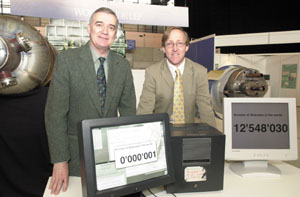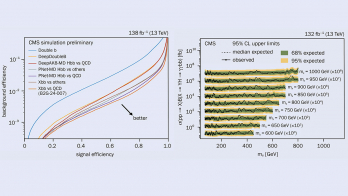The World Wide Web was conceived at CERN to allow particle physicists easy access to information, wherever it was and they happened to be. It was a great success, so great that it went on to take the whole world by storm – a veritable communications revolution.
CERN Courier News Editor James Gillies teamed up with CERN World Wide Web pioneer Robert Cailliau to write a detailed history of modern telecommunications, particularly as seen through CERN eyes. As the book points out, the fact that the Web was invented at CERN “is no accident”.
How the Web was Born by James Gillies and Robert Cailliau, Oxford University Press, ISBN 0192862073, pbk.
This book is a surprising, ambitious, interesting and courageous account of a series of developments culminating in the invention at CERN of the World Wide Web. It is not only a history of the Web – it covers in considerable detail the necessary evolution of networks, personal computers and software technology which enabled Tim Berners-Lee’s brilliant creation of the Web in 1989.

I say “surprising” because it had seemed to me that enough good Internet histories had already been written (Salus 1995; Hafner and Lyon 1996; Randall 1997). Furthermore, Berners-Lee’s own account Weaving the Web was published only last year (Berners-Lee 1999). However, there is much new material in this book. I call it “ambitious” and “interesting” because it covers all the surrounding areas in depth and is not afraid to follow sidetracks, personalities and anecdotes, which are always the key to attracting and holding a reader’s attention.
The book reveals the quirky human attitudes and the bureaucratic and business struggles which make this a real human story rather than just a dateline of cold technological developments. Finally, it is “courageous” because, although written by two CERN authors, it is truthful even about those parts of the story which are not too flattering to CERN.
There is not much to criticize. The first 10 pages on telephones and LANs contribute little, are messy and may deter some readers from reaching the true start of the story. My attention was first aroused on p11 by the phrase: “The Birth of the Internet: On 31 January 1958, the United States launched Explorer I, its first satellite, though few now remember that.”
There are some minor slips of detail: for example, STELLA was a CERN satellite project, not an Italian one (p81), and began in 1978, not in 1981 (p317). The proofreading of the book was also not up to my expectations of Oxford University Press.
Essentially, however, this book makes a major contribution. I believe the authors have succeeded with their aim “to tell a story of human endeavour, and to provide a good read in the process”. They stress the multiplicity of contributions of many individuals over half a century, including the essential ones and without forgetting the elements of accident and personality which often proved crucial.
Humour abounds: Senator Edward Kennedy, in congratulating the Boston team that had won a contract for an ARPANET Interface Message Processor (IMP), refers to it as an “interfaith” processor. When the first IMP was delivered to UCLA and found in horror to be upside down in its crate, a team member declared this only “meant that it had been turned over an odd number of times”. This was after finding that the IMP had survived.
There is also much wisdom, such as that of Frank Heart, manager of the small Bolt, Beranek and Newman team developing the IMP, which he described as follows: “All the software people knew something about hardware, and all the hardware people programmed. It was a set of people who all knew a lot about the whole project. I consider that pretty important in anything very big.”Thirty years later, nothing much has changed.
The battles of culture and practice between proprietary, ISO and TCP/IP networking, fought to the death between the late 1960s and the early 1990s, are handled with insight and accuracy. This is required reading for today’s younger generation, many of whom surprise me by their casual ignorance of what was for some of us a struggle over many years, dividing colleagues, damaging careers and delaying progress towards the now realized dream of a networked world.
Culture and practice continue to collide in the later chapters, where we approach the fateful few years where all the strands will meet. Berners-Lee’s personal trajectory is followed, showing how his curiosity and taste for research was nurtured and amplified by contact with like minds, first by his parents, teachers and other early influential figures, and later by collaboration and discourse with CERN colleagues and the blossoming Internet community. With the Web idea launched outside CERN, the germination and maturation of the software worldwide is then traced in detail, including the NCSA/Mosaic/Netscape saga and the demise of competing products like Gopher and Archie.
The book captures the rare combination of Berners-Lee’s talents: steady vision, broad interests and detailed attention. It shows the triumph of a mind that could arrive at something simple, starting from a situation where things were deeply complicated beforehand. The idea that order could be created in the chaotically non-standard environments of document exchange and networking as they stood in the late 1980s was simply unbelievable for practically everyone at that time.
Berners-Lee’s success serves as a living example of the power and the necessity of the KISS principle – “Keep It Simple, Stupid” – which tells us to be humble in the face of the world’s ever growing complexity. There is also a quality in him of those inexperienced youngsters, recruited by Data General during a classic underground project to develop the world’s fastest minicomputer, specifically because they were too naive to know that certain things “can’t be done” (Kidder 1981).

Why, if it was all so simple, did the Web take so long to arrive – 20 years after the start of the Internet? And why at CERN? This latter question is carefully examined by the authors, who say “it is no accident that it happened at CERN” and cite several supporting reasons. For me, the most convincing reason was Berners-Lee’s own statement that it was “…a question of being in the right place at the right time…in the right environment”, and: “…with great bosses in Peggie Rimmer and Mike Sendall, and a lot of stimulating colleagues, all prepared to think outside the box”.
The other burning question addressed by the book is: why did CERN “give away” the Web and lose its creator to MIT? It is a complex matter, taking up the entire last chapter of the book. Starting with Berners-Lee’s chance meeting with Michael Dertouzos of MIT/LCS, a complex web of interests and rivalries is traced between US and European players: CERN, INRIA, NCSA, MIT, Mosaic Communications and the European Commission. Bluff, counterbluff and misunderstandings succeeded each other. But the bottom line appears to be that CERN, fighting a life-or-death battle for approval of the LHC project, lacked basic commitment to a non-physics activity, even one of such huge potential.
The book is dedicated to the memory of two people: first to Donald Davies, pioneer of packet switching, the most essential of all Internet components; and second to Mike Sendall, who in 1989 “did not say no to Tim Berners-Lee and consequently the Web got off the ground”. Let me wholeheartedly applaud that conclusion: not saying no to the young and starry-eyed is one way the world can advance from chaos to order, from the impossible to the imaginable.
Ben Segal is currently leader of CERN’s Technology for Experiments Section, responsible for development in areas including High Performance and Storage Area Networks and CERN’s online Central Data Recording service, and is responsible for Data Management within the new European “Data Grid” Project. From 1985 until 1988, he served as CERN’s first TCP/IP coordinator, responsible for the introduction of the Internet protocols within CERN. In 1995, he was a co-founder of the Internet Society (ISOC) Geneva Chapter.
Further reading
K Hafner and M Lyon 1996 Where Wizards Stay up Late Simon & Schuster.
P Salus 1995 Casting the Net Addison Wesley.
N Randall 1997 The Soul of the Internet Thomson.
T Berners-Lee 1999 Weaving the Web Harper.
T Kidder 1981 Soul of a New Machine Atlantic Monthly Press.








